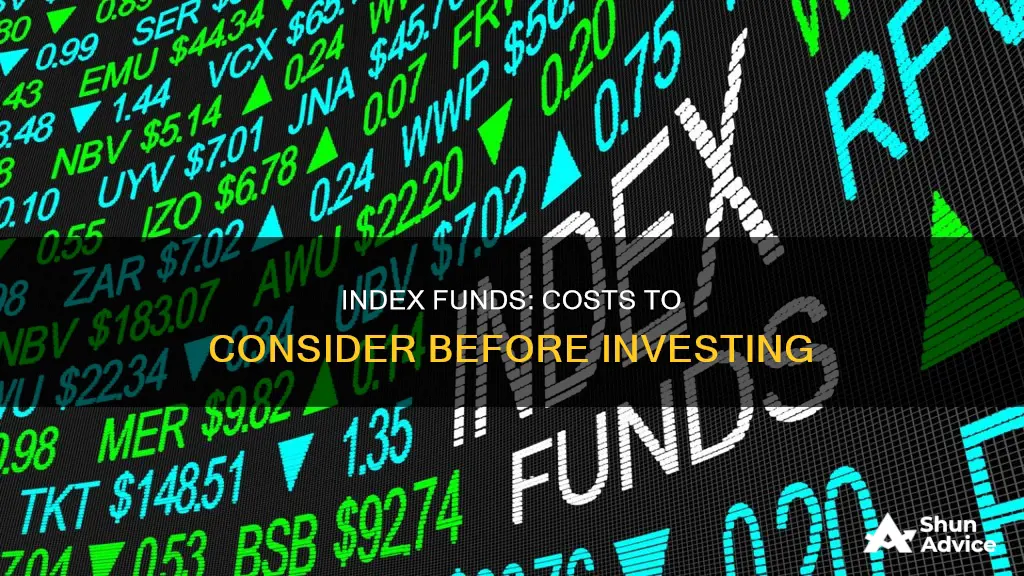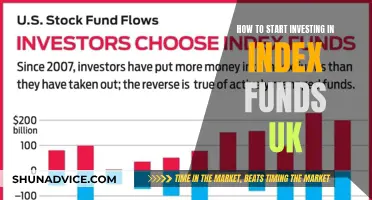
Index funds are a popular investment choice due to their low costs, diversification, and passive management strategy. They are a type of mutual or exchange-traded fund (ETF) that tracks the performance of a market index, such as the S&P 500, by holding the same stocks or bonds. These funds have lower fees than actively managed funds as they do not require research analysts and have lower transaction costs. The average fee for an index fund is 0.05%, and some funds offer even lower expense ratios. When investing in index funds, it is important to consider the fund's performance, expenses, taxes, and investment minimums. While index funds are generally considered safe due to their diversification, they are still subject to market risks and may underperform in certain sectors or during market downturns. Overall, index funds offer a low-cost, easy way to build wealth and are suitable for both beginner and experienced investors.
| Characteristics | Values |
|---|---|
| Average annual return for the S&P 500 | 10% |
| Average fee for an index fund | 0.05% |
| Average stock index ETF fee | 0.16% |
| Average stock mutual fund fee | 0.44% |
| Average stock index mutual fund fee | 0.05% |
| Average expense ratio of a stock mutual fund | 0.44% |

Management fees
Expense ratios are important because they are one of the most significant factors in an investor's total return. When comparing index funds, it is essential to consider the expense ratio, as funds with higher expense ratios can significantly eat into investment returns over time. Additionally, it is worth noting that while index funds are generally cheaper than actively managed funds, some index funds have lower fees than others.
According to data from 2022, the average stock index mutual fund charged an expense ratio of 0.05% (on an asset-weighted basis), while the average stock index ETF charged 0.16%. However, it is worth noting that some index funds have even lower expense ratios, such as the BNY Mellon U.S. Large Cap Core Equity ETF (BKLC), which charges a true 0% expense ratio.
When evaluating index funds, it is also important to consider other factors such as investment minimums, account minimums, trading costs, fund options, and convenience. However, the expense ratio remains a key factor in determining the overall cost of investing in an index fund.
Smart Ways to Invest $25,000 in Mutual Funds
You may want to see also

Sales loads
It's also worth noting that mutual funds tend to be less tax-efficient than ETFs. At the end of the year, many mutual funds pay a taxable capital gains distribution, while ETFs do not. This is another factor to consider when deciding between a mutual fund or ETF for your index fund investment.
When purchasing an index fund, you can either buy directly from the mutual fund company or through a broker. However, it's usually easier to buy a mutual fund through a broker, and if you're buying an ETF, you'll need to go through a broker.
Liquid Funds: A Smart Investment Move?
You may want to see also

Expense ratios
Index funds are a type of mutual or exchange-traded fund (ETF) that tracks the performance of a market index, such as the S&P 500, by holding the same stocks or bonds or a representative sample of them. They are passively managed, meaning they do not have a team of analysts and portfolio managers actively trying to beat the market. As a result, they have lower fees and costs than actively managed funds.
When choosing an index fund, it is important to compare expense ratios, as they can vary significantly, even among funds tracking the same index. While a higher expense ratio may be justified if a fund is tracking an index with better long-term performance, there is no reason to pay more for an index fund tracking the same index.
- Vanguard S&P 500 ETF: 0.03%
- Vanguard Large-Cap ETF: 0.04%
- Schwab U.S. Large-Cap ETF: 0.03%
- Vanguard Mid-Cap ETF: 0.04%
- Schwab U.S. Mid-Cap ETF: 0.04%
- Vanguard Small-Cap Growth ETF: 0.05%
- IShares Core S&P Small-Cap ETF: 0.06%
- Schwab U.S. Broad Market: 0.03%
- IShares Core S&P Total US Stock Market: 0.03%
- Vanguard Total Stock Market: 0.04%
Launching an Investment Hedge Fund: A Comprehensive Guide
You may want to see also

Tax-cost ratios
The tax-cost ratio is a measure of how much a fund's annualised return is reduced by the taxes investors pay on distributions. This is calculated by Morningstar for products such as mutual funds and Exchange Traded Funds (ETFs). The tax-cost ratio is an important consideration for taxable investors, as the more distributions a fund makes, the larger the tax-cost ratio will be, and the larger the amount of return lost to taxes. This is known as the "tax drag".
The tax-cost ratio is not often discussed, but it can represent an additional headwind to after-tax investment results. For example, investors in US large cap or small cap equities lost roughly 1.8% of return per year to taxes, while fixed-income investors lost nearly 1.3%. Over five years, a balanced portfolio consisting of 30% US equities, 20% international equities and 50% fixed income would have given up nearly the entire pre-tax return of 1.9% to taxes, delivering just 0.3% after accounting for tax drag.
The tax-cost ratio comes from taxes owed on distributions such as dividends or capital gains paid to a fund's shareholders. A high tax-cost ratio may be the result of a fund that has regularly paid out large amounts of dividend income, or a fund that employs an investment strategy that results in frequent capital gain distributions.
There are three general "buckets" that tax rates can fall into. The worst from a tax perspective is non-qualified dividends, short-term capital gains and interest income, which are taxed as ordinary income and can carry a top rate of 40.8%. Qualified dividends and long-term capital gains are taxed at a more favourable rate of 23.8%, while municipal bond interest and unrealized capital appreciation are taxed at 0%.
The tax-cost ratio has the potential to negatively impact investment performance, detracting from positive returns and making negative returns even worse. For example, a fund that realises an overall annual return of 5% but charges expenses totalling 2% will mean that 40% of the fund's return is lost to fees.
Index funds are considered to be tax-efficient, as they have lower turnover rates, which usually result in fewer capital gains distributions.
European Funds: Smart Investment or Risky Business?
You may want to see also

Capital gains taxes
Index funds are considered to be tax-efficient because they generate less taxable income than actively managed funds. This is due to their passive investing strategy, which involves less frequent trading and therefore fewer transactions that could be subject to capital gains taxes.
Index funds are also more tax-efficient because they are able to choose which lots to sell when selling a particular security. This means they can sell the lots with the lowest capital gains and therefore minimise the tax owed.
However, it is important to note that index funds are still subject to capital gains taxes. In the US, these taxes are incurred on profits from the sale of investments held in a fund for more than one year. The tax rate depends on how long you held the investment and your income level, with rates ranging from 0% to 28% as of 2023.
When investing in index funds, it is important to consider the tax implications, especially if you are investing through a taxable brokerage account. While index funds are generally more tax-efficient than actively managed funds, there can still be tax implications when the fund sells securities at a profit.
Additionally, index funds are required to distribute realised capital gains to shareholders at the end of the year, which can create an annual tax liability for investors. This is known as a capital gains distribution. However, fund managers have ways to minimise this, such as by using a fund's losses to offset its gains.
Overall, while index funds are considered to be tax-efficient compared to other types of funds, it is important to understand the potential tax implications when investing in these funds.
Mutual Fund Investment: Quick, Easy, and Accessible
You may want to see also
Frequently asked questions
An index fund is a type of mutual or exchange-traded fund (ETF) that tracks the performance of a market index, such as the S&P 500, by holding the same stocks or bonds or a representative sample of them.
The costs of investing in index funds include expense ratios, which are fees subtracted from each fund shareholder's returns as a percentage of their overall investment. Some index funds may also charge sales loads or commissions.
Index funds generally have lower costs than actively managed funds, which employ teams of analysts and portfolio managers to try to beat the market. According to data from the Investment Company Institute in 2024, the average fee for an index fund is 0.05%, with some funds offering even lower expense ratios.
Yes, index funds offer broad diversification, low risk, and tax advantages compared to actively managed funds. They are also a simple and hands-off investment option, making them suitable for beginners.







